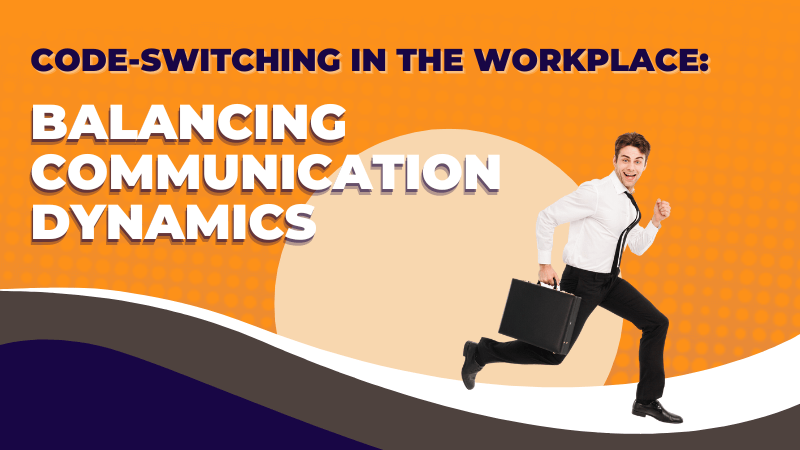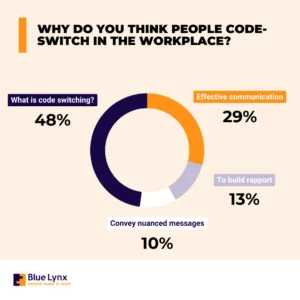Code-Switching in the Workplace: Balancing Communication Dynamics

Code-switching is the practice of switching between different languages, dialects, or communication styles. It is a powerful tool that helps professionals handle multilingual and multicultural interactions. In this article, I’m going to explore the nuances of code-switching in the workplace, types, implications, benefits, and best practices.
What Constitutes Code-Switching in the Workplace?
Code-switching in the workplace involves an effortless transition between different linguistic or cultural codes to facilitate communication. This can include switching between languages, dialects, registers, or even communication norms within a single conversation. The goal is to ensure that others properly understand the message you’re trying to convey, regardless of their language or cultural backgrounds.

Different Types of Code-Switching in a Business Environment
Language Code-Switching
This involves switching between two or more languages within a conversation. For instance, a bilingual employee might start a sentence in English and transition to their native language for a more nuanced or impactful explanation to make sure they don’t get lost in translation.

Dialect Code-Switching
Within a single language, people might switch between different dialects or regional variations depending on the context and the people they are having a conversation with.
Register Code-Switching
People naturally adapt their language or tone to match the formality of a situation. This might involve switching between formal and informal language, depending on the audience.
Examples of Workplace Code-Switching
Multilingual Meetings
Our Talent Acquisition Agency – Blue Lynx – has offices in The Netherlands, Bulgaria and Columbia. In an international meeting, a team member might begin the conversation in English, switch to Spanish or Dutch to address a specific point, and then return to English for the summary. On the one hand, this can be done to make sure the message they have is conveyed clearly. On the other, it can also be perceived as a means of establishing a closer connection with your remote colleagues by speaking in their native tongue.
Cultural Norms
As an employee coming from a strong culture that values hierarchical communication, I still often switch to a more direct communication style when interacting with colleagues even though Blue Lynx has a flat organisational structure.

Communication with Senior Leadership
Most senior leaders are united by one common trait – they are always busy on the hamster wheel. This means if you want to strike up a conversation, you’d need to get to the point fast and directly. You may be accustomed to long casual conversations with team members, but if you want to get the CEO’s attention you better not beat around the bush and always back your statements up with data.
Reasons for Code-Switching in the Workplace
Inclusivity
Code-switching ensures that all participants in the conversation can actively engage in discussions and understand the topic.
Effective Communication
Different languages or communication styles might carry nuances that allow for clearer and more precise explanations of a particular word, phrase or situation.

Building Rapport
Code-switching can foster a sense of solidarity by showing respect for others’ backgrounds.
The Cost of Code-Switching in the Workplace
In 2012, a viral video depicted President Barack Obama’s distinct greetings for a white assistant coach and black NBA player Kevin Durant. Funny enough, it even inspired a sketch on Comedy Central. This behavioural shift is known as “code-switching” and has profound implications for black professionals in the workplace, impacting their well-being, economic progress, and even their safety. In fact, according to the Society for Human Resource Management, 77% of Black Americans and 66% of Latinos report having to code-switch at work.

The Dilemma of Code-Switching at Work
Our research highlights that code-switching is a significant issue for black employees in the workplace. While it is often seen as essential for career advancement, it comes at a considerable psychological cost. Black professionals often feel they cannot fully express themselves at work. This poses a challenge to inclusion and social equality in organisations.
Some of the reasons to employ code-switching strategies could involve career aspirations, organisational fit, vigilance, and the diversity climate within the workplace.
Benefits of Code-Switching in the Workplace
Code-switching in the workplace is often regarded as a sign of cultural intelligence and adaptability, according to Harvard Business Review.
Employees who can seamlessly transition between languages, communication styles, and cultural norms demonstrate their capacity to navigate diverse environments effectively.
This cultural dexterity not only reflects positively on the individual but also enhances the organisation’s ability to thrive in an increasingly globalised world.
Moreover, code-switching serves as a powerful tool for building relationships and fostering connections with a wide range of people. The Society for Human Resource Management highlights that employees who can adapt their communication to different audiences are better equipped to connect with colleagues, clients, and partners from diverse backgrounds.
This ability to bridge cultural and linguistic gaps not only promotes inclusivity but also lays the foundation for stronger professional relationships, which can lead to enhanced collaboration and teamwork within the organisation.

Furthermore, code-switching enhances effective communication across various situations.
Harvard Business Review suggests that employees who can tailor their language and communication styles to match the formality, context, or audience of a given situation are more likely to convey their ideas clearly and persuasively.
This flexibility in communication ensures that messages are not lost in translation, contributing to more efficient problem-solving and decision-making processes within the workplace.
Companies that recognise and value these advantages of code-switching are well-positioned to attract and retain top talent, reinforcing their commitment to creating inclusive and culturally diverse environments.
Recommendations for Action
According to a study by Deloitte, 80% of respondents say that inclusion is a major decision-influencing factor when choosing an employer.
For Organisations
- Evaluate company culture for pressure to code-switch and ensure inclusivity
- Address underrepresentation at all levels to make cultural identities normative
- Promote diversity and inclusivity separately, focusing on fostering inclusive environments

For Leaders and Coworkers
- Practice inclusive behaviours, actively learn about cultural differences
- Reflect on personal identities and encourage others to bring more of themselves to work
- Be mindful of biases and avoid pointing out differences unnecessarily
- Provide Context – Offer a brief explanation or provide context if needed.
Code-switching is the practice of switching between different languages, dialects, or communication styles. It is a powerful tool that helps professionals handle multilingual and multicultural interactions. In this article, I’m going to explore the nuances of code-switching in the workplace, types, implications, benefits, and best practices.
What Constitutes Code-Switching in the Workplace?
Code-switching in the workplace involves an effortless transition between different linguistic or cultural codes to facilitate communication. This can include switching between languages, dialects, registers, or even communication norms within a single conversation. The goal is to ensure that others properly understand the message you’re trying to convey, regardless of their language or cultural backgrounds.
Different Types of Code-Switching in a Business Environment
Language Code-Switching
This involves switching between two or more languages within a conversation. For instance, a bilingual employee might start a sentence in English and transition to their native language for a more nuanced or impactful explanation to make sure they don’t get lost in translation.
Dialect Code-Switching
Within a single language, people might switch between different dialects or regional variations depending on the context and the people they are having a conversation with.
Register Code-Switching
People naturally adapt their language or tone to match the formality of a situation. This might involve switching between formal and informal language, depending on the audience.
Examples of Workplace Code-Switching
Multilingual Meetings
Our Talent Acquisition Agency – Blue Lynx – has offices in The Netherlands, Bulgaria and Columbia. In an international meeting, a team member might begin the conversation in English, switch to Spanish or Dutch to address a specific point, and then return to English for the summary. On the one hand, this can be done to make sure the message they have is conveyed clearly. On the other, it can also be perceived as a means of establishing a closer connection with your remote colleagues by speaking in their native tongue.
Cultural Norms
As an employee coming from a strong culture that values hierarchical communication, I still often switch to a more direct communication style when interacting with colleagues even though Blue Lynx has a flat organisational structure.
Communication with Senior Leadership
Most senior leaders are united by one common trait – they are always busy on the hamster wheel. This means if you want to strike up a conversation, you’d need to get to the point fast and directly. You may be accustomed to long casual conversations with team members, but if you want to get the CEO’s attention you better not beat around the bush and always back your statements up with data.
Reasons for Code-Switching in the Workplace
Inclusivity
Code-switching ensures that all participants in the conversation can actively engage in discussions and understand the topic.
Effective Communication
Different languages or communication styles might carry nuances that allow for clearer and more precise explanations of a particular word, phrase or situation.
Building Rapport
Code-switching can foster a sense of solidarity by showing respect for others’ backgrounds.
The Cost of Code-Switching in the Workplace
In 2012, a viral video depicted President Barack Obama’s distinct greetings for a white assistant coach and black NBA player Kevin Durant. Funny enough, it even inspired a sketch on Comedy Central. This behavioural shift is known as “code-switching” and has profound implications for black professionals in the workplace, impacting their well-being, economic progress, and even their safety. In fact, according to the Society for Human Resource Management, 77% of Black Americans and 66% of Latinos report having to code-switch at work.
The Dilemma of Code-Switching at Work
Our research highlights that code-switching is a significant issue for black employees in the workplace. While it is often seen as essential for career advancement, it comes at a considerable psychological cost. Black professionals often feel they cannot fully express themselves at work. This poses a challenge to inclusion and social equality in organisations.
Some of the reasons to employ code-switching strategies could involve career aspirations, organisational fit, vigilance, and the diversity climate within the workplace.
Benefits of Code-Switching in the Workplace
Code-switching in the workplace is often regarded as a sign of cultural intelligence and adaptability, according to Harvard Business Review.
Employees who can seamlessly transition between languages, communication styles, and cultural norms demonstrate their capacity to navigate diverse environments effectively.
This cultural dexterity not only reflects positively on the individual but also enhances the organisation’s ability to thrive in an increasingly globalised world.
Moreover, code-switching serves as a powerful tool for building relationships and fostering connections with a wide range of people. The Society for Human Resource Management highlights that employees who can adapt their communication to different audiences are better equipped to connect with colleagues, clients, and partners from diverse backgrounds.
This ability to bridge cultural and linguistic gaps not only promotes inclusivity but also lays the foundation for stronger professional relationships, which can lead to enhanced collaboration and teamwork within the organisation.
Furthermore, code-switching enhances effective communication across various situations.
Harvard Business Review suggests that employees who can tailor their language and communication styles to match the formality, context, or audience of a given situation are more likely to convey their ideas clearly and persuasively.
This flexibility in communication ensures that messages are not lost in translation, contributing to more efficient problem-solving and decision-making processes within the workplace.
Companies that recognise and value these advantages of code-switching are well-positioned to attract and retain top talent, reinforcing their commitment to creating inclusive and culturally diverse environments.
Recommendations for Action
According to a study by Deloitte, 80% of respondents say that inclusion is a major decision-influencing factor when choosing an employer.
For Organisations
- Evaluate company culture for pressure to code-switch and ensure inclusivity
- Address underrepresentation at all levels to make cultural identities normative
- Promote diversity and inclusivity separately, focusing on fostering inclusive environments
For Leaders and Coworkers
- Practice inclusive behaviours, actively learn about cultural differences
- Reflect on personal identities and encourage others to bring more of themselves to work
- Be mindful of biases and avoid pointing out differences unnecessarily
- Provide Context – Offer a brief explanation or provide context if needed
To Sum It Up
Code-switching is a valuable tool that fuels effective communication in multicultural workplaces. By embracing its benefits and navigating its potential challenges, professionals can build cross-cultural bridges, foster collaboration, and enhance inclusivity. At Blue Lynx, we recognise the significance of code-switching in today’s global business landscape. Discover how we can assist you in your executive search journey to thrive in diverse professional environments.
